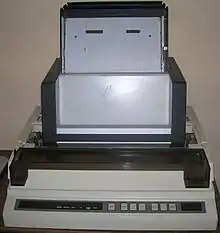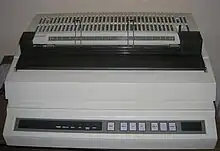
The Diablo 630 is a discontinued daisy wheel style computer printer sold by the Diablo Data Systems division of the Xerox Corporation beginning in 1980.[1][2] The printer is capable of letter-quality printing; that is, its print quality is equivalent to the quality of an IBM Selectric typewriter or printer, the de facto quality standard of the time.
Overview
The printer is capable of this quality at a nominal speed of 30 characters per second (roughly twice the speed of the Selectric). Several technologies were introduced to enable this quality and speed:
- The lightweight daisy wheel is rotated by a closed-loop servo and can be positioned rapidly and accurately. Because the wheel can turn in either direction, the next character is never more than 180° away from the previous character (and related characters are grouped together so the average "seek" is much less than 180°).


- Like the "typeball" element on a Selectric, the daisy wheel can be easily changed, allowing for a wide variety of fonts and character pitches.
- Some models can use wheels with two rows of characters, allowing for the machine to print in two different languages or with a large set of special symbols.[3]
- The printer uses cartridge-loaded ribbons; both an economical endless cloth ribbon and a high-quality single-use film ribbon were available, with colored ribbons provided by third parties. By contrast, Selectric-based printers can use only one type of ribbon—cloth or single-use carbon film—and were almost always equipped for the former for economic reasons.
- The carriage is also servo-controlled and the printer can print with the carriage moving either forward or backward, saving most of the time that would otherwise be spent executing carriage returns.
- The servo control of the carriage permitted the use of proportionally-spaced fonts, wherein each character does not have to occupy the same amount of horizontal space.
- Unlike Selectric-based printers, daisy wheel printers support the entire ASCII printing character set.
- Bidirectional paper motion is similarly servo-controlled, allowing quick printing of subscripts and superscripts as well as fast slewing past white space.
- Servo control of both paper and carriage permitted the unit to be used for plotting, with resolution of 120×48 steps per inch.[4][5] This was popular enough that special daisy wheels were made with a reinforced period (.), the character most often used for plotting.
- The logic permits simultaneous motion of the wheel, the carriage, and the paper. The hammer automatically strikes only after all three motions complete. This minimized the time spent waiting for the motions to complete.
A related model, the Diablo 1620, includes a keyboard and strongly resembles a slightly overgrown Selectric typewriter. In fact, a "local/remote" switch permits it to be used as an offline typewriter as well as an interactive computer terminal. Unfortunately for a typist (in either role), the daisy wheel mechanism hides the area just printed. Firmware in the machine makes the carriage move quickly to the right of the typing position, revealing the most recently typed characters, after a few moments of inactivity. The result was still unsatisfactory to many users. Only a very slow typing speed would allow the wheel to get out of the way after every character; faster typing speeds resulted in the wheel continuously hiding the typed copy until the typist paused. This made checking the copy for errors a bit more awkward and slow than on actual typewriters or on Selectric-based terminals.
The same mechanism was used in Xerox's 850 display typing system and 860PDS word processor, and was also sold to OEMs. One notable user was Digital Equipment Corporation, who resold the printer as the LQP01 (with a parallel interface) and the LQPSE (with an RS-232 serial interface), supported by Digital's WPS-8 word processing software.
The printer became so common, with so much software supporting its command language, that Diablo emulation became an expected feature on other daisy-wheel printers and even on early laser printers.[6] This was so pervasive that at least one company lived by testing printers for full Diablo 630 compatibility.[7]
References
- ↑ Alexander R. Hammer (March 14, 1972). "Xerox to Acquire Disk-Drive Maker For $28-Million". The New York Times.
- ↑ "Xerox 1999 Fact Book". Archived from the original (MS Word) on 3 March 2016.
- ↑ Diablo Systems, Inc. (January 1984). "Model 630/630 ECS Printers/Terminals API Interface" (PDF). p. 1-1. Retrieved 19 February 2010.
The API/ECS Model 630 ... can operate with Diablo's ECS print wheels which can contain two characters per spoke, or up to 192 characters per print wheel. The model 630 ECS/IBM operates with Diablo's specially designed ECS IBM print wheel for the IBM PC character set, as well as all of the 88-, 92- and 96-character print wheels.
- ↑ Diablo Systems, Inc. (January 1984). "Model 630/630 ECS Printers/Terminals API Interface" (PDF). pp. 3–56. Retrieved 19 February 2010.
The minimum possible increment of horizontal movement is 1/120... The minimum possible increment of vertical movement is 1/48."
- ↑ Thom Hogan (March 1984). "Creating a letterhead with your daisywheel printer". Creative Computing. Vol. 10, no. 3. p. 202.
In the horizontal direction, the Diablo (and others) is capable of moving the printhead 1/120 of an inch at a time [...] In the vertical direction the Diablo can move the print mechanism in increments of 1/48 of an inch. Thus, the maximum density of information you can print using a Diablo 630 is 120 X 48 in a square inch.
- ↑ Google search for Diablo 630 emulation
- ↑ Early Laserprinter Development
Further reading
- Comstock, George E. (2003-08-13). "Oral History of George Comstock" (PDF). Interviewed by Hendrie, Gardner. Mountain View, California, USA: Computer History Museum. CHM X2727.2004. Archived (PDF) from the original on 2017-03-23. Retrieved 2017-03-23.
External links
- Diablo Model 630/630 ECS Printers/Terminals API Interface Complete description of printers and command language, with all modes
- Brief description of Diablo 630 command language
- Diablo 630 to PostScript Translator